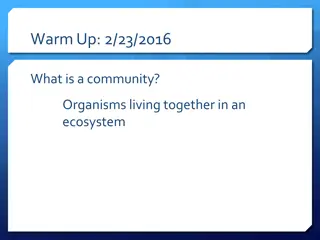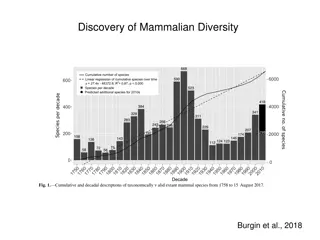A Comparative Analysis of Ectothermy vs. Endothermy in Organisms
Ectotherms regulate body temperature externally, relying on environmental heat sources, while endotherms produce heat internally. Ectotherms like reptiles and fish have advantages such as lower metabolic rates and food requirements, while endotherms like birds and mammals have higher energy needs due to internal heat production. Understanding the costs and benefits of these thermoregulation strategies provides insights into the evolutionary adaptations of different organisms.
Download Presentation

Please find below an Image/Link to download the presentation.
The content on the website is provided AS IS for your information and personal use only. It may not be sold, licensed, or shared on other websites without obtaining consent from the author.If you encounter any issues during the download, it is possible that the publisher has removed the file from their server.
You are allowed to download the files provided on this website for personal or commercial use, subject to the condition that they are used lawfully. All files are the property of their respective owners.
The content on the website is provided AS IS for your information and personal use only. It may not be sold, licensed, or shared on other websites without obtaining consent from the author.
E N D
Presentation Transcript
Topic: Costs and Benefits of Ectothermy Relative to Endothermy
Ectotherms: Definition: These are organisms which control their body temperature through external means .
The name ectotherm comes from the Greek ekotos meaning outside and therm meaning heat. They depend on environmental heat source. Their body temperature rises and falls with their environment.
Examples of ectotherm: These includes: Reptiles Fish Insects Plants Vertebrates
Endotherms: Definition: These are organisms which produce heat through internal means .
The name endotherms also comes from the Greek, endo meaning inside. The internal temperature is independent of the outside temperature.
Examples of endotherms: These includes: Birds Mammals(humans) Marsupials Monotremes
Regulation of Temperature Ectotherm Endotherm Ectotherms have limited ability to control their body temperature,so they regulate it by Behavioural adaptations. Seeking shade or sunshine Huddling togethers Movement of wings to absorb light and warmth Endotherms require about 5 times as much food as ectotherms of the same size. They have a lot more mitochondria per cell_the organelles which make energy A high rate of metabolism of fats and sugars generates a lot of heat.
Advantages of ectotherms: 1. Ectotherms may gain benefits by living at a lower metabolic rate. Because their body temperatures generally remain close to ambient temperatures,they expand relatively little energy to ambient thermoregulation. 2. Ectotherms require less food,so they can spend less time foraging and more time quietly avoiding predators. .
3. Ectotherms also need less water because they lose less by evaporation from their typically cooler surfaces,and they need not be massive in order to achieve an effective surfaces_to _volume ratio. 4. The benefits to ectotherms of low metabolic rte are balanced by the costs,including the inability of ectotherms to regulate their body temperatures. 5. Ectotherms can invest a larger proportion of their energy budget in growth reproduction.
Advantages of endotherms: 1. The respective costs and benefits of ectothermy are the benefits and costs of endothermy.Because of their high rates of aerobic respiration and their elevated temperatures,endotherms can generally sustain longer periods of intense activity. 2. Endothermy is that the constancy of body temperatures allows enzymes to function more efficient over a relatively narrow range.
3. The field metabolic rates of endotherms are up to 20 times higher than the field metabolic rates of ectotherms. 4. Large quantity of energy is consumed by an endotherms to elevate and maintain its body temperatures,only a relatively small proportions of its energy can be budgeted for growth and reproduction. 5. Endotherms that allow the body temperatures to rise and fall during activity and rest ,respectively ,echo the basking behavior of some reptiles.























